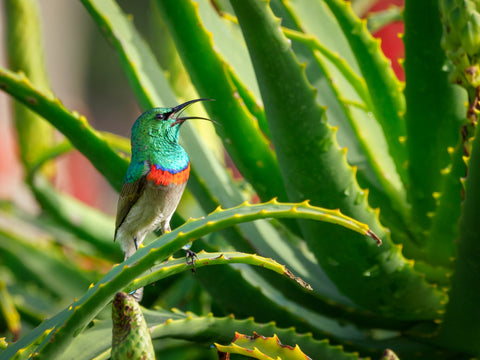Hummingbird Nectar Recipes: Attracting and Nourishing Your Winged Guests
In this blog post you'll learn different hummingbird nectar recipes and much more.
There's nothing quite as magical as witnessing the delicate dance of hummingbirds in your garden. These tiny, vibrant creatures are a delight to behold as they flit around, their iridescent feathers catching the sunlight. If you want to invite these enchanting visitors to your outdoor space, providing them with nourishing nectar is the way to go.

Crafting your own hummingbird nectar is not only simple and cost-effective, but it also ensures that you're offering your feathered friends a wholesome and refreshing treat. Let's explore some hummingbird nectar recipes that will help you attract and nourish these remarkable creatures.
Looking for an easy to fill feeder? Checkout this best selling vintage red hummingbird feeder.
Understanding Hummingbird Nectar
Before we dive into the recipes, it's important to understand the basics of hummingbird nectar. Hummingbirds primarily feed on flower nectar, which is rich in sugars that provide them with energy. Commercial hummingbird feeders often contain a mixture of water and white granulated sugar. It's crucial to avoid using artificial sweeteners, honey, brown sugar, or other additives, as they can be harmful to hummingbirds.
Recipe #1: Classic Hummingbird Nectar
Ingredients:
- 1 part white granulated sugar
- 4 parts water
Instructions:
- Boil the water to remove impurities. Allow it to cool to room temperature.
- In a clean container, mix the sugar and water in the specified ratios. Stir until the sugar is completely dissolved.
- Fill your hummingbird feeder with the nectar mixture and hang it in a suitable location.
Recipe #2: Enhanced Hummingbird Nectar
Ingredients:
- 1 part white granulated sugar
- 4 parts water
- A pinch of turmeric (for color)
Instructions:
- Boil the water and allow it to cool to room temperature.
- Mix the sugar and water in the specified ratios in a clean container. Stir until the sugar is fully dissolved.
- Add a small pinch of turmeric to the nectar mixture. This natural ingredient adds a touch of color to the nectar without harmful dyes.
- Fill your hummingbird feeder with the nectar and place it in a location where you can easily observe the visitors.
Recipe #3: Flower-Infused Hummingbird Nectar
Ingredients:
- 1 part white granulated sugar
- 4 parts water
- Edible flower petals (e.g., hibiscus, rose, or lavender)
Looking for a unique hand blown glass hummingbird feeder?
Instructions:
- Boil the water and let it cool to room temperature.
- Mix the sugar and water as per the ratios in a clean container. Stir well to dissolve the sugar.
- Add a small handful of edible flower petals to the mixture. The petals not only add a subtle flavor but also make the nectar visually appealing.
- Fill your feeder with the flower-infused nectar and hang it in a place that receives adequate sunlight and is easily accessible to hummingbirds.
Tips for Successful Hummingbird Feeding:
-
Cleanliness Matters: Regularly clean your hummingbird feeders to prevent mold and bacteria buildup. Rinse with hot water and scrub with a bottle brush, avoiding soap or chemical cleaners.
-
Frequency of Refilling: Hummingbird nectar should be changed every 3 to 5 days, depending on the temperature. In warmer weather, it may spoil more quickly, so monitor the nectar's condition regularly.
 Looking for a rustic styled hummingbird feeder? How about a mason jar glass hummingbird feeder!
Looking for a rustic styled hummingbird feeder? How about a mason jar glass hummingbird feeder! -
Shade and Sun: Hang your feeders in a spot that provides a mix of shade and sunlight. This helps prevent the nectar from overheating, which can be harmful to hummingbirds.
-
Placement: Place feeders near flowering plants to provide a natural food source and create an inviting environment for hummingbirds.
-
Avoid Red Dye: While some commercial nectars are red to attract hummingbirds, it's best to avoid adding red dye to your homemade nectar. The dye may be harmful to these delicate creatures.
-
Be Patient: It might take a little time for hummingbirds to discover your feeder. Once they do, they'll become frequent visitors.
-
Plant Native Plants: To complement your nectar feeders, consider planting native flowers that provide a natural source of food for hummingbirds.

By offering homemade nectar using these recipes, you're providing hummingbirds with a reliable and nutritious source of energy. Additionally, your garden will likely become a haven for these delightful visitors, allowing you to witness their vibrant beauty up close.
Here's one of our best selling glass hummingbird feeders.
Remember, creating a welcoming environment for hummingbirds goes beyond just providing food—planting suitable flowers, offering water sources, and maintaining a safe space are all part of ensuring these tiny wonders feel at home in your garden. So, gather your ingredients, mix up some nectar, and prepare to be amazed as these miniature marvels grace your outdoor space with their presence.








 * Find this feeder
* Find this feeder 

